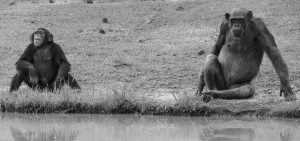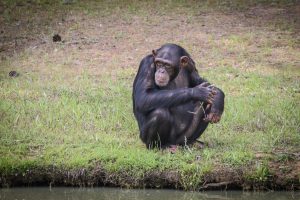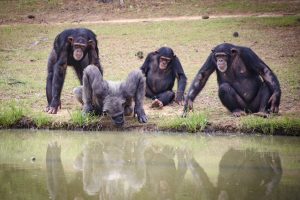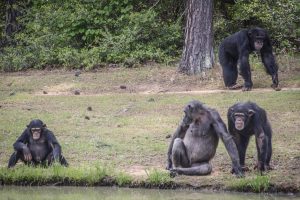Chimp Haven Is Truly a Treasure
by admin | April 21, 2022 8:43 pm
Thanks to a dear friend, my Beautiful Mystery Companion and I took a tour of the world’s largest sanctuary for chimpanzees last weekend and met – at a distance – Valentina Rose, the 10-year-old chimp our friend sponsored for my BMC’s birthday. She received an adorable chimp doll, a certificate, and a photo of her new “best friend.”
Chimp Haven is a nonprofit facility located on 200 acres inside the 1,200-acre Eddie D. Jones Nature Park in Keithville, Louisiana — an unincorporated area about 20 miles south of Shreveport. It currently cares for 325 chimps formerly used in biomedical research, the entertainment business or, bizarrely, as pets. While chimps were used extensively for research into hepatitis and HIV in the 1980s, new technology and research models led to a steep decline in their use.
So, what to do with all those chimps? Chimp Haven, founded in 1995, received a federal contract after Congress passed the CHIMP Act (Chimpanzee Health Improvement Maintenance) in 2000. Caddo Parish, where Keithville is located, donated 200 acres of heavily forested land inside the nature park. Chimp Haven set about creating a sanctuary where the chimps live in large social groups, an average of a dozen or so to each habitat, which are separated by tall fences with mesh at the bottom and either wood or concrete at top, so the chimps can’t climb over. The chimps can safely build nests in trees if they wish which allows them to live safely in a natural environment. The chimps can sleep inside or outside, as they choose. They are lovingly cared for by a 70-employee staff that includes veterinarians and other trained support staff. Since the goal is to acquire as many research lab chimps as possible – all but 50 have been retired by the National Institutes of Health, the chimps are sterilized to prevent births that would require more care, though a handful of “accidents” have happened. No chimps are ever returned to laboratories. Besides federal funding, Chimp Haven actively seeks outside donations. It costs about $17,000 annually to care for each chimp, according to its website.
Chimp Haven has built a series of moats. They contain underwater walls that keep the chimps from getting into deep water. Chimps are very muscular and don’t contain enough body fat to float. The moat allows them to bend down and get a drink to moisten the feed mixture that is a big part of their diet. They cram their mouths full, take a swig of water, then carry the doughy lump around in their hands, taking bites. Chimps also get bananas, of course, and lots of other fruit and vegetable treats.
 [1]
[1]  [2]
[2]  [3]
[3]  [4]
[4]  [5]
[5]
Since chimps can catch many of the diseases that humans carry, we were required to wear masks on the tour. Long before the COVID-19 pandemic, staff always wore protective gear so not to infect the chimps, who genetically are the closest species to humans that exist. While they play with the chimps, it is always at a distance, maybe a little tickle session with a stick from 10 feet away. Chimps are very strong and could quickly seriously injure or even kill someone even if the intent was just to indulge in a little horseplay.
As the tour began with about 20 folks under a large gazebo by the first moat, the chimps began to come out to inspect their human counterparts across the water. One of the staff pointed out Valentina Rose to my BMC, along with her mom, Flora, who is always close by. The dad, Mason, lurked in the background. The chimps are beautiful creatures with expressive faces and differing personalities. Like humans, they vary widely in size and appearance. They were also much larger than I imagined, some seeming to approach 6 feet in height if they stood up straight. Chimps have opposable thumbs on their feet and tend to walk on all fours.
Our tour guide (this was the first tour since the pandemic began) was Michelle Reininger, the colony director, who was amazing in her ability to name every chimp we saw and her knowledge of the facility. She delivered a 30-minute lecture about Chimp Haven while Hayden, one of the friendlier chimps, hung from the wire mesh on the other side of the glass and tried to get our attention by rattling the fence. If someone squatted down eye-to-eye with Hayden, he would start making faces and expect you to do the same.
Chimp Haven is a treasure, a well-run retirement home for these noble members of an endangered species. Chimps in sanctuaries like this can live into their 60s. Long may they live.
Find out more about Chimp Haven by visiting their website at chimphaven.org.
- [Image]: http://garyborders.com/pages/chimp-haven-is-truly-a-treasure/walking-chimp/
- [Image]: http://garyborders.com/pages/chimp-haven-is-truly-a-treasure/valentina-mom-bw/
- [Image]: http://garyborders.com/pages/chimp-haven-is-truly-a-treasure/valentina-rose/
- [Image]: http://garyborders.com/pages/chimp-haven-is-truly-a-treasure/checking-out-the-water/
- [Image]: http://garyborders.com/pages/chimp-haven-is-truly-a-treasure/valentinas-family/
Source URL: https://garyborders.com/pages/chimp-haven-is-truly-a-treasure/